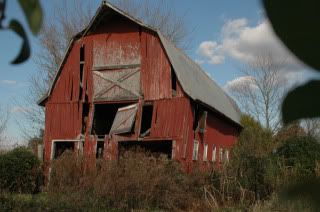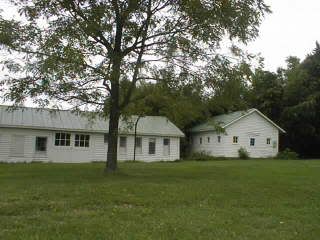The Barn.
We do not know exactly how old our barn is, but we know it is not the original barn for the property. The materials used and the construction techniques have lead us to believe that it was built shortly after the turn of the 20th century. When we bought this place, the barn was in sad shape. One of the main beams on the west gable end had failed, and the building was beginning to twist and fall. Over the course of about 5 months, a local builder took it apart piece by piece, replaced all the rotten framing, reinforced the remainder of the building, replaced the rotten siding, and gave her a brand new coat of red paint. She’s ready, now, to stand for at least another hundred years.
Before:
During:
Almost …
After!
The Tack Shed.
This building has been used by former owners of our property as a pump house, a storage building for dairy equipment, and a place to dump horse tack. We plan to use it in the main nursery area for storage and display space. It needs a lot of work … but we see its potential.
Garage.
The garage is built in the same spot that was occupied by an old machine shed. The shed was 20 feet wide and 65 feet long, probably dating from the middle of the 20th century, and it had been modified over the years to hold tractors, and goats, and rabbits, and other machinery and supplies. Water infiltration rotted most of the framing, and we made the difficult decision to tear it down and put a new building in its place.
Before:
After:
The Workshop.
The first time we toured the property with our realtor, I saw this cute little building with its own electric meter, and I claimed it for my workshop. At the time, the building was jammed full of junk and trash – we cleaned it out, and made countless trips to the landfill. The only cool thing we found in all that mess was half a piece of the original Gothic trim for the house’s former dormer.
Here’s the workshop on the right, with the original machine shed on the left. What looks like a grouping of trees to the right of the workshop is actually a huge grove of bamboo.
The Greenhouse is the newest addition to the property. We designed it to make use of salvage materials that I have collected over the past two years. The walls are plastic right now, because cold weather arrived early this year and I had to use the place to shelter the baby roses. Next spring, I will take down the plastic and put in wood windows that came from two 1960’s houses that had their original windows replaced. The skylights are from a remodeling project in southern Maryland. Even the timbers that form the foundation are reclaimed – they were once a retaining wall.

Behind the house, tucked under the limbs of a massive pecan tree, overlooking the Rambler Fence, is the pavilion – affectionately known as the Tiki Hut. It was completed this summer, to provide space for parties, classes, demonstrations, and other rose-filled events.
This is just a short overview to get you acquainted. I expect that I will probably spend a whole day’s entry on each structure later, you can see more before and after photos.




















